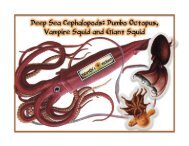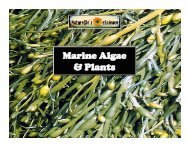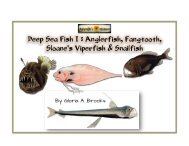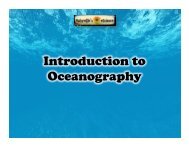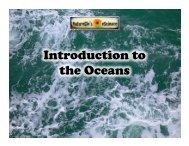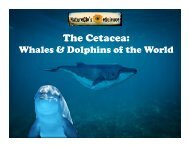NeS Lesson #1 - Deep Sea Communities Slideshow Rvsd72317
Create successful ePaper yourself
Turn your PDF publications into a flip-book with our unique Google optimized e-Paper software.
By Gloria A. Brooks<br />
Creative Commons & Public<br />
Domain Images Used
Natureglo’s eScience Copyright 2016<br />
Revised 7/23/17<br />
Permission is granted to reproduce this PowerPoint per student in a one family household,<br />
per student & teacher in one teacher’s classroom and for the purchaser’s personal use only.<br />
Thank you. Please noHfy me at gab21921@gmail.com for other circumstances. Thank you.<br />
Cover – A Dumbo octopus with deep sea corals. Images credit: NOAA.<br />
All images – Creative Commons & public domain images used.<br />
All images used in this presentation are either used with Creative Commons<br />
license or are in the public domain.<br />
Background image: © 2014 Rebeccarawrr. Licensed under CC-BY.
What are <strong>Deep</strong> <strong>Sea</strong> <strong>Communities</strong>?<br />
• Organism groups associated by shared deep sea habitats<br />
• Why mostly unexplored? technological, logistical & expense challenges<br />
visiting deep sea biomes (large natural habitat)<br />
• Since 19th century - biodiversity discovered existing in deep seas<br />
• 4 main energy sources & nutrients - marine snow, whale falls,<br />
hydrothermal vents, cold seeps<br />
• Sparse food makes bottom dwellers opportunistic (take immediate<br />
advantage of new food sources)<br />
• <strong>Deep</strong> sea creatures special adaptations – very slow growth, larval<br />
dispersal, ability to use ‘transient’ food resource<br />
A Sabortooth fish Coccorella atrata, a deep<br />
sea fish, similar to the saber-toothed tigers,<br />
named for their oversized, recurved<br />
palatine teeth. Found at depths of 600 –<br />
3,300 feet. A public domain image.
• <br />
<br />
• <br />
<br />
<br />
• <br />
<br />
<br />
• <br />
<br />
• <br />
<br />
<br />
Dana viperfish<br />
Elongated bristlemouth fish<br />
Frill shark by Mario<br />
Sánchez Bueno<br />
Giant<br />
Squid<br />
A Chain catshark (mesopelagic zone), public domain image.<br />
A deep sea cucumber<br />
photographed by NOAA.
History of <strong>Deep</strong> <strong>Sea</strong> Community Discovery<br />
• Before 19th century - scientists assumed deep<br />
sea life sparse<br />
• 1870’s, Sir Charles Thompson – with colleagues<br />
aboard Challenger expedition discovered many<br />
deep-sea creature varieties<br />
• February 17, 1977 - 2 scientists, J. Corliss and J.<br />
van Andel, first witnessed dense chemosynthetic<br />
clam beds from submersible DSV Alvin<br />
• 1979, eastern Pacific - first discovery of deep-sea<br />
chemosynthetic community at hydrothermal<br />
vents during geological explorations<br />
• Challenger <strong>Deep</strong>, southern Mariana Trench near<br />
Mariana Islands - deepest surveyed point of all<br />
oceans; reported depth: 4,475 fathoms (10.99<br />
kilometers or 6.83 miles)<br />
Images – Left: USO (Unidentified Swimming Organism). Right: Okeanos Explorer. Images, courtesy of the<br />
NOAA Office of Ocean Exploration and Research, 2015 Hohonu Moana.
History of <strong>Deep</strong> <strong>Sea</strong><br />
Community Discovery Part II<br />
• 1960, Don Walsh and Jacques Piccard descended to bottom<br />
of Challenger <strong>Deep</strong> in Trieste bathyscaphe; saw small<br />
flounder-like fish moving away from bathyscaphe spotlight<br />
• March 1995 - Japanese remote operated vehicle (ROV) Kaiko<br />
second vessel to reach Challenger <strong>Deep</strong> bottom<br />
• May 31, 2009, Nereus, hybrid remotely operated vehicle<br />
(HROV) - only vehicle capable of exploring ocean depths<br />
beyond 7000 meters; reached Challenger <strong>Deep</strong> depth of<br />
10,902 meters<br />
• June 2009, sonar mapping of Challenger <strong>Deep</strong> Simrad EM120<br />
using multibeam sonar bathymetry system aboard R/V Kilo<br />
Moana, maximum depth: 10,971 meters (6.817 miles)<br />
Tube worms from the Okeanos Explorer deep sea expeditions. Photographed by NOAA.
<strong>Deep</strong> <strong>Sea</strong> Creature Adaptations <br />
to Great Pressure<br />
• Great pressure - greatest environmental factor acting on deep-sea organisms<br />
• Animal adaptations allow survival in sub-photic zones extreme pressure <br />
• Pressure coping - many small fish, usually not exceeding 25 cm in length<br />
Greater living depth adaptations:<br />
• Gelatinous (jelly-like) flesh<br />
• Minimal skeletal structure<br />
• No excess collapsible cavities<br />
(holes or pockets), i.e. swim<br />
bladders (bony fish gas filled sac<br />
aiding buoyancy)<br />
“Life on the abyssal sea floor (depths<br />
ranging from 4000-6000 m) near the<br />
Hudson Canyon off the coast of New<br />
Jersey. Photo taken using the <strong>Deep</strong><br />
Submersible Research Vessel (DSRV)<br />
Alvin's camera system. Image courtesy<br />
of <strong>Deep</strong> East 2001, NOAA/OER.”<br />
• Most deep sea under pressures<br />
between 200 and 600 atm<br />
(atmospheres of pressure); pressure<br />
range from 20 to 1,000 atm
<strong>Deep</strong> <strong>Sea</strong> Temperatures<br />
• From epipelagic base (or bottom) - temperature drops over several<br />
hundred meters to 5 or 6 °C (42 or 43 degrees Celsius) at 1,000<br />
meters; temperatures decrease slowly towards bottom<br />
• Below 3,000 to 4,000 m, water isothermal (constant temperature);<br />
no seasonal or annual temperature changes; no other habitat on<br />
Earth with such constant temperatures<br />
• <strong>Deep</strong>est ocean water temperatures – mostly between 0-3 degrees<br />
Celsius (32-37.5 degrees Fahrenheit)<br />
• Hydrothermal vents – water temperature from "black smoker"<br />
chimneys as high as 400 °C (752 degrees Fahrenheit)<br />
Background image – A hydrothermal vent. Image credit: NOAA.<br />
“The red line in this illustration shows<br />
a typical seawater temperature<br />
profile. In the thermocline,<br />
temperature decreases rapidly from<br />
the mixed upper layer of the ocean<br />
(called the epipelagic zone) to much<br />
colder deep water in the thermocline<br />
(mesopelagic zone). Below 3,300 feet<br />
to a depth of about 13,100 feet,<br />
water temperature remains constant.<br />
At depths below 13,100 feet, the<br />
temperature ranges from near<br />
freezing to just above the freezing<br />
point of water as depth increases.”<br />
Quote and diagram from NOAA.
• Upper photic<br />
zone - filled with<br />
particle organic<br />
matter (POM);<br />
productive,<br />
especially in<br />
coastal and<br />
upwelling areas<br />
• POM composed of<br />
dead plant &<br />
animal matter<br />
<strong>Deep</strong> <strong>Sea</strong> Community Food<br />
Source: Marine Snow<br />
• Time delay long<br />
enough for<br />
particles to<br />
remineralize and<br />
be taken by<br />
organisms in<br />
food webs<br />
• Most POM – small, light;<br />
may take many years to<br />
settle through water<br />
column to deep ocean<br />
floor<br />
Image – Marine snow. Image courtesy of NOAA Okeanos<br />
Explorer Program, MCR Expedition 2011.
<strong>Deep</strong> <strong>Sea</strong> Community Food Source: Whale Falls<br />
• Whale fall (or death) - most important deep sea community event<br />
• Brings hundreds of tons of organic food matter to sea bottom<br />
Whale Fall Community Consumption Three Stages:<br />
1. Mobile scavenger stage: big and mobile scavengers arrive<br />
immediately after whale falls to bottom; organisms can include:<br />
amphipods, crabs, sleeper sharks, hagfish<br />
“A whale fall community, including<br />
bacteria mats, clams in the<br />
sediments, crabs, worms, and a<br />
variety of other invertebrates.<br />
The 35-ton gray whale carcass<br />
originally settled on the seafloor<br />
at 1,674 meters depth in 1998.<br />
This photo was taken six years<br />
later.” Image and quote by NOAA.
Whale Fall Consumption Stages 2 & 3 Continued<br />
2. Opportunistic stage: example organism: tube worm,<br />
Osedax; larva born without a sex; surrounding<br />
environment determines larva’s sex; larva settles on whale<br />
bone, turns into female; larva settles on or in female,<br />
turns into dwarf male<br />
3. Sulfophilic stage: further bone decomposition and<br />
seawater sulfate reduction occurs; bacteria create<br />
sulphide-rich environment similar to hydrothermal vents;<br />
organisms can include: polynoids, bivalves, gastropods and<br />
other sulphur-loving creatures<br />
Background transparency – A North Atlantic Right Whale by H. Zell.<br />
A whale fall off the coast of San<br />
Diego, CA, photographed by NOAA.
Chemosynthesis from Hydrothermal Vents<br />
• Chemosynthesis definition – organic compounds bacteria<br />
synthesis (combination causing reaction) or other living<br />
organisms using energy derived from reactions involving<br />
inorganic chemicals, typically without sunlight<br />
• 1977 Hydrothermal vents discovered by scientists from Scripps<br />
Institution of Oceanography<br />
• Hydrothermal vents discovery - located at plate boundaries: East<br />
Pacific, California, Mid-Atlantic ridge, China and Japan<br />
• New ocean basin material made in regions such as Mid-Atlantic<br />
ridge as tectonic plates pull away from each other<br />
• Plate spreading rate - 1–5 cm/yr.<br />
Image - White flocculent mats in and around the extremely<br />
gassy, high-temperature (>100°C, 212°F) white smokers at<br />
Champagne Vent. Image by NOAA and in the public domain.
Chemosynthesis from Hydrothermal Vents Part II<br />
• Cold sea water circulates down through cracks between two plates;<br />
cold water heats as passes through hot rock<br />
• Minerals & sulfides dissolve into water during rock interaction<br />
• Hydrothermal vent creation - hot solutions emanate from active subseafloor<br />
rift<br />
• Bacteria chemosynthesis provides energy and organic<br />
matter for whole food web in vent ecosystems<br />
A deep sea vent<br />
diagram created<br />
by Hannes Grobb.<br />
An active hydrothermal vent chimney<br />
spewing out hydrothermal fluids. Image<br />
credit: NOAA.
A Hydrothermal Vent Diagram<br />
A public domain image.
Organisms at Hydrothermal Vents<br />
• Giant tube worms - grow up to 2.4 m (7 ft. 10 in) tall<br />
because of rich nutrients<br />
• Over 300 new species discovered<br />
• Entire ecosystems independent from sunlight; first evidence<br />
Earth can support life without sun<br />
Images – Left: immense deep sea community by a hydrothermal vent. Right: Giant<br />
tube worms. Images by NOAA and in the public domain.
Cold Seeps<br />
Background image – Methane<br />
streams coming from a cold-seep<br />
site on the upper slope (water<br />
depth less than 500 meters<br />
[1,640 feet]) offshore Virginia.<br />
Image courtesy of NOAA Okeanos<br />
Explorer Program.<br />
• Sometimes called cold vents<br />
• Ocean floor area where hydrogen sulfide, methane and other<br />
hydrocarbon-rich fluid seepages occur, often in brine pool form<br />
• "Cold” – doesn’t mean seepage temperature lower than surrounding<br />
sea water; its temperature often slightly higher<br />
• Biomes support several endemic (plants or animals native or<br />
restricted to certain area) species<br />
• Develop unique topography over time; reactions between methane<br />
and seawater create carbonate rock formations and reefs
Cold Seep Types<br />
• Distinguished according to depth,<br />
as shallow cold seeps and deep<br />
cold seeps<br />
<br />
Different Cold Seep Types:<br />
<br />
• Oil/gas <br />
• Gas - methane seeps<br />
• Gas hydrate <br />
• Brine - form brine pools<br />
• Mud volcanoes<br />
• Pockmarks<br />
A methane seep<br />
Mud Volcano<br />
<strong>Deep</strong> water gas plumes<br />
Background image – Brine pools.<br />
All images on this slide photographed by NOAA.
References<br />
1. University of Hawaii Marine Center (4 June 2009). "Inventory of<br />
ScienAfic Equipment aboard the R/V KILO MOANA". Honolulu, Hawaii:<br />
University of Hawaii. Retrieved 18 June 2010.<br />
2. Smith, Jr, H.A. Ruhl, B.J. BeV, D.S.M. BilleV, R.S. LampiV & R.S.<br />
Kaufmann (17 November 2009). "Climate, carbon cycling, and deepocean<br />
ecosystems". PNAS 106 (46): 19211–19218. Bibcode:2009PNAS..<br />
10619211S. doi:10.1073/pnas.0908322106. PMC 2780780. PMID<br />
19901326. Retrieved 19 June 2010.<br />
3. Jorge Csirke (1997). "II. The Limits of Marine ProducAvity". In Edward<br />
A. Laws. El Niño and the Peruvian Anchovy Fishery (series: Global<br />
Change InstrucAon Program) (PDF). Sausalito: University Science<br />
Books. p. 4. doi:10.1023/A:1008801515441. ISBN 0-935702-80-6.<br />
Retrieved 18 June 2010.<br />
4. Encyclopædia Britannica (2010). "PhoAc zone". Encyclopædia<br />
Britannica Online. Retrieved 18 June 2010. External link in |publisher=<br />
(help)<br />
5. Wikipedia <strong>Deep</strong> <strong>Sea</strong> CommuniAes arAcle: hVps://en.wikipedia.org/<br />
wiki/<strong>Deep</strong>_sea_communiAes<br />
A deep-sea squid of the<br />
family Cranchiidae. It has a<br />
large ammonia-filled body<br />
chamber used to help with<br />
buoyancy. Image from<br />
NOAA Okeanos Explorer.
Thank you for watching!<br />
A squat lobster on a deep-sea octocoral. Image courtesy of NOAA Okeanos Explorer<br />
Program, Gulf of Mexico 2014 Expedition.






